Marine Airpower’s Future: Networking F-35s, V-22s, & MUX Drones
Posted on
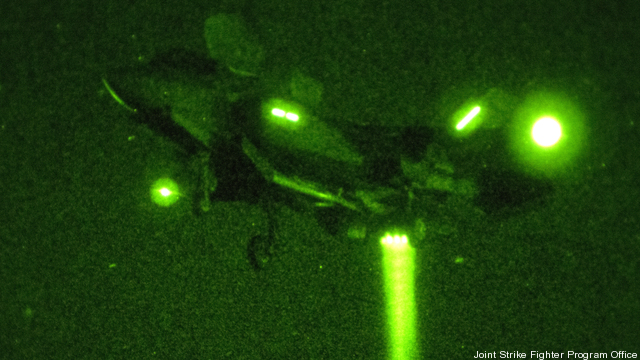
A Marine F-35B in vertical landing mode.
CAPITOL HILL: The Marine Corps’ top pilot sketched a vision of fast-paced and networked air operations, spearheaded by F-35 fighters, V-22 tiltrotors, and the future MUX drones, all linked to each other and the rest of the force by Link-16 and MADL.
Marine F-35s have already practiced spotting targets for Marine artillery rockets and Navy missile defenses, Lt. Gen. Jon Davis told reporters. Now imagine those F-35s linked to swarms of MUX drones — cheaper and more expendable than manned fighters — that provide even more sensor data, more firepower, more jamming and even resupply. Imagine V-22 Osprey tiltrotors, escorted by F-35s and MUX, carrying fuel, munitions and spare parts to hardscrabble forward airbases, where the fighters and drones can land to refuel, rearm, and return to the fight without flying back to the fleet.

Lt. Gen. Jon Davis
The goal is to sustain a relentless tempo of strikes in the teeth of high-tech defenses — even while the Navy ships that support Marine operations hang back out of range of land-based cruise missiles. The challenge of so-called Anti-Access/Area Denial threats and the opportunities of new technology have triggered an upsurge of tactical innovation, especially among young Marines.
“It’s a good time to be a US Marine,” Davis told reporters after a Senate airpower hearing yesterday. Visibly enthused, he described one development after another as “exciting” and wishing aloud that he could get in the cockpit himself. (After 37 years in uniform, Davis is in fact retiring next month). “I wish I was younger so I could fly this thing, but I’ll have to vicariously watch other people do it,” he said.
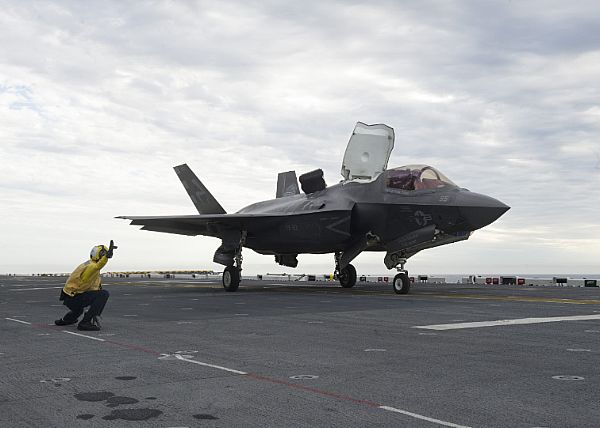
F-35B
The innovation is especially vibrant in the F-35 community, Davis said. And that community extends beyond the Marines, he emphasized: “It’s really cool, the synergy between the services.”
While Navy F-35Cs won’t reach Initial Operational Capability until 2019, “the Marine Corps and the Air Force IOC’d already, and already we’re integrating our weapons schools at Yuma and at Nellis,” Davis said. A Marine is flying F-35As as an instructor in the Air Force school at Nellis, while an Air Force F-35A pilot is getting his F-35B qualification to instruct at Yuma.
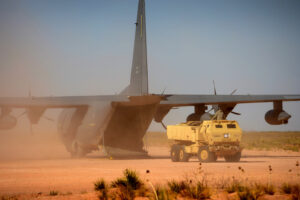
A HIMARS (High-Mobility Artillery Rock System), rocket launchers stowed for travel, backs onto an Air Force MC-130J transport during an exercise.
Yuma’s Weapons & Tactics Instructors (WTIs) are at the forefront of exploring new ways to use the new plane, such as having an F-35 spot ground targets and transmit targeting data to Guided MLRS artillery rockets. The launcher itself had been flown in on a C-130 transport, Davis added, simulating a “rocket artillery raid” — the kind of rapid deployment of heavy firepower to a forward base that is central to future Marine Corps concepts of operations.
For this initial experiment, the F-35 pilots had to manually relay target data to the artillery unit on the ground, Davis said, but “the next WTI class will probably look for automatic target handoff to the GMLRS battery.”
To pass data from F-35s to other forces, Davis said, “Link-16’s one way we do that right now, (but) we’d like to have higher fidelity, higher bandwidth data,” for example by using (the) Multifunction Advanced Data Link (MADL) built into F-35s. MADL was originally meant as a way for F-35s to communicate with each other, undetected by the enemy, but the military is now experimenting with MADL links to other systems. In a test last fall, for example, an F-35 passed target data via MADL to a Navy Aegis air and missile defense system. The Aegis wasn’t on an actual ship but rather a test installation at White Sands Missile Range, the so-called Desert Ship.

A Navy SM-6 interceptor missile destroys a simulated cruise missile in a test at White Sands Missile Range.
In the White Sands test, Davis explained, there was an incoming cruise missile that the “ship” couldn’t see with its own radars because it was hidden behind a mountain range. Flying much higher than a ship’s radar mast and therefore enjoying a much wider field of view, the F-35 saw the missile and transmitted target data via MADL. The ship fired a SM-6 interceptor missile and shot the threat down. What Davis may know and be keeping to himself is just how much greater is range and sensitivity of the F-35’s sensors. But he did offer a few hints.
“The sensors in the F-35, the radar, are really, really strong. It’s exceptional, there’s nothing like it in the world,” Davis enthused. “It’s the smartest kid in class.” In one F-35 flight out of Yuma, he said, “they asked us to look at a missile launch from Vandenberg and we tracked it all the way to space with the F-35.”
“It’s a King Kong killing machine,” Davis said. “It sees stuff and it’s able to kill stuff, very, very effectively. It sees through the weather, air to air targets, air to ground targets.…. Now we’re trying to push the information from that airplane, offboard that” to the rest of the force.
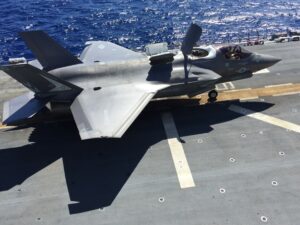
F-35B aboard the amphibious ship USS Wasp
The next big step in F-35 experimentation will be deploying on big-deck amphibious ships, starting with squadron VMFA-121 this summer. Davis suggested using the deployment as a test for the “lightning carrier” concept. The idea is to pack an amphib with all the F-35Bs it can carry and use it as a kind of mini-Nimitz, rather than the current model in which it’s mainly a helicopter carrier with some Harriers aboard.
“As soon as that ship gets there, if they wanted to put all 16 airplanes they have aboard the ship, they could go. And if I were them, I would,” Davis said. “We, as a nation, should experiment with this capability.”
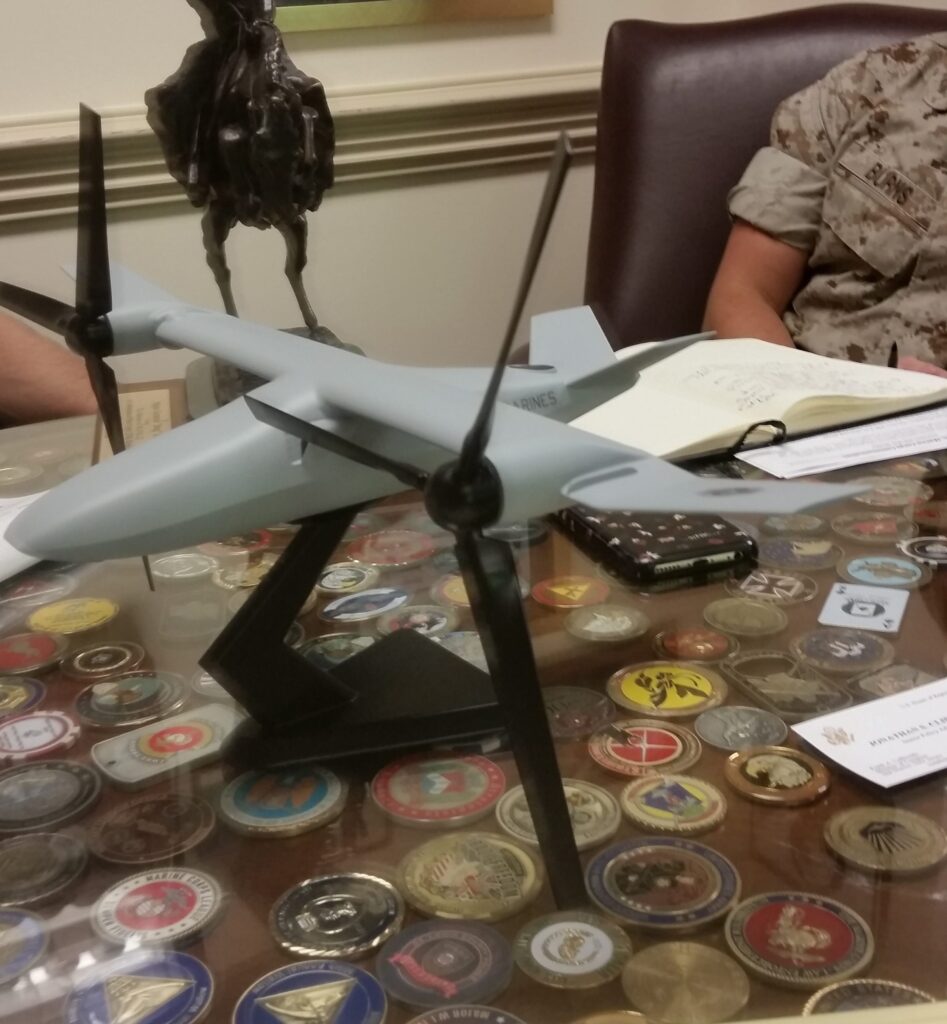
A model of the Bell V-247 concept for MUX on Marine Corps Lt. Gen. Jon Davis’s desk.
MUX & V-22
The usually unarmed V-22 transport is increasingly the workhorse of the Marine Corps — and, with the new CMV-22 variant, the Navy as well. Its range and speed increased the Marines’ reach sixfold over the geriatric CH-46 helicopter, so no wonder they set the benchmark for the new Marine Unmanned eXpeditionary (MUX) drone.
“V-22…totally changed how we project power from a seabase and how people look at a MEU (Marine Expeditionary Unit): 450-mile radius vice a 75-mile radius,” Davis said. So for MUX, the Marines want “range specs at least as good as V-22; air speed at least as good as V-22; and air refuelable (like V-22); can land vertically on board a ship (like V-22).”
One of MUX’s major missions will be escorting V-22s into combat zones, something jet fighters are too fast to do while attack helicopters are too slow. But that’s just one of a wide array of roles Davis envisions for a multi-mission MUX.
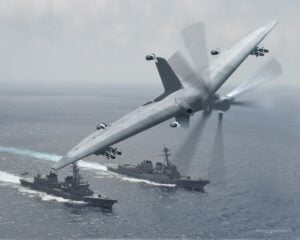
Tern, DARPA’s proposed ship-launched drone.
It “not only does death and destruction from on high, (flies) long range to escort V-22s and be a mission partner in manned/unmanned teaming for F-35s, but also has a cargo requirement as well,” he said. “We think it will carry an air to air radar, so it will give us airborne early warning. It will give us electronic warfare, it will give us air-to-air fires, air-to-ground fires, (and) airborne resupply at range.” He later mentioned Intelligence, Surveillance, & Reconnaissance (ISR) and communications relay missions as well.
“It’s actually pretty exciting,” Davis said. “There are a couple of people that are building prototypes”: Northrop Grumman, Bell, Boeing, and Karem Aerospace. “I think the first airplane to fly, the first model, will fly in the fourth quarter of ’17.”
When you combine all these aircraft — the V-22 and MUX, which take off and land vertically like a helicopter, and the F-35B, which is a short takeoff/vertical landing “jump jet” — you get some “really interesting” options to operate independently of both conventional concrete airfields and 1,000-foot-long supercarriers. “The naval service is trying to power project from a seabase,” Davis said. “But what if I’m operating from a long way away? Now what happens to my surge sortie rate?”
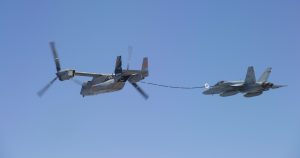
A V-22 refuels a Navy F-18 fighter.
Traditionally, supercarriers and big-deck amphibs alike operate relatively close to land, cutting down on the distance their aircraft have to travel to and from targets. Increasingly long-range anti-ship missiles, however, are forcing the fleet to seek refuge further and further offshore. Increasing the distance aircraft have to travel increases the time required for each sortie and therefore reduces the sortie rate, cutting the number of troops and bombs that can delivered to targets each day. But what if you had a pit stop between the ship and the target?
“Combine shipboard platforms with a land base, (an ad hoc) little strip out there,” Davis said. “With our F-35s and (MUX), a VTOL UAV, I can actually get out there at range, expend my ordnance, drop in, get rearmed and reloaded and back airborne again.” The aircraft would only return to the ship for maintenance too complex for the austere land bases to handle.
While Davis focused on F-35 and MUX operating out of these Expeditionary Advance Bases (EAB), other thinkers and publications make clear the EABs would depend on the V-22s to function. Only the tiltrotors have the combination of range, speed, and carrying capacity to bring in operationally significant quantities of ammunition and fuel. What’s more, the V-22s are being upgraded to provide in-flight refueling to F-35s and other aircraft.
Other Marine Corps aircraft would certainly play their own roles. Really heavy gear would have to be delivered to forward bases by CH-53 helicopter, which is slower but huskier than the V-22. Smaller helicopters — AH-1 gunships, UH-1 transports, Navy H-60s — would run shorter-range missions, including protecting the fleet from submarines and fast attack boats. But the crucial synergy is the V-22’s long-range cargo capacity, the F-35’s sensors, and the MUX’s versatility.
Subscribe to our newsletter
Promotions, new products and sales. Directly to your inbox.
